3 June 2016
On the cultural heritage in the Baztan Valley
Promoting the arts in Baztania in the Modern Age
Ms. Pilar Andueza Unanua
Chair of Navarrese Heritage and Art
If we go through the parishes of the valley of Baztanllama attention the presence of numerous sculptures of the eighteenth century out of the gouges of the sculptor Luis Salvador Carmona, the best Spanish sculptor of his time, and we also discover in the sacristies various pieces from the Villa y Corte, New Spain or Guatemala. No less surprising is to find the building mass of the convent of the Poor Clares of Arizkun, of Madrid roots. In view of these first-rate cultural assets, we must ask ourselves how it is possible that in the periphery of the peninsula, in a remote valley with difficult access, the best art then being produced in the territories of the Hispanic monarchy was consumed in the 18th century.
The answer can be found once again in what Caro Baroja called "the Navarrese hour of the XVIIIth century", a phenomenon that also favored the frenetic construction activity developed in the valley around houses and palaces from the end of the XVIIth century and a good part of the Age of Enlightenment.The emigration of many people from Baztania at that time, their service to the monarchy in high positions in the administration, the army and the Church, or their dedication to important businesses, led to the training of important estates that reverted to a large extent in their homeland, whether they returned to it or not. The house and the family left behind benefited from his generosity. But also their deep religious convictions and their Christian piety, as well as the magnificence to which many believed themselves obliged by the economic and social condition achieved, led many of those emigrants from their places of destination -mainly Madrid and the Indies- to send works of art and monetary remittances to rebuild or improve the parishes where they had received their baptismal waters, to endow them with altarpieces and even to found convents. These gifts, moreover, gave a good account before their countrymen of the power they had attained. It is worth mentioning the role played in this sense by unmarried uncles or unmarried uncles who had no offspring, and the very endogamous marriage policy in the valley, which allowed the social progression of numerous families, is of great importance for the analysis of this phenomenon.
Although the list of people from Baztanes who fit these profiles is very extensive, we will highlight some of the most outstanding ones. Among the most relevant characters in the promotion of the arts, Juan Bautista Iturralde, born in the Iturraldea house in Arizkun, stood out in a special way.
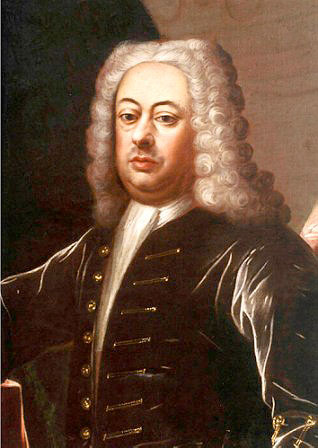
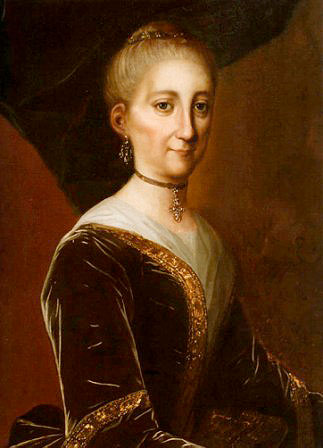
Juan Bautista Iturralde and his wife Manuela Munárriz
(Convent of the Poor Clares of Arizkun)
Friend and partner of Juan de Goyeneche, he settled in Madrid before 1699 and dedicated himself with great success to business. Among them he had in his hands the supply of provisions, gunpowder and armament of the army between 1712 and 1729, although his most profitable business was the loan that he made to Felipe V of a million pesos escudos, in exchange for which the monarch ceded him in 1725 his rents of the kingdom of Granada. In 1739 he was appointed Secretary of State and Universal Office of Finance and obtained the degree scroll of Marquis of Murillo. Besides paying for the reconstruction of his native house in 1716, he founded together with his wife Manuela Munárriz, a board of trustees of pious works in 1731, which meant the erection of numerous foundations of subject religious, educational and welfare. Thanks to this in Arizkun both sponsored the convent of Our Lady of the Angels of the Poor Clares in 1736, although the negotiations had begun in 1731. The designs, which arrived from Madrid and seem to be the work of Fausto de Manso, allowed the construction of a monumental convent, in which the facade of great dynamism and color stands out. The designs of the altarpieces also seem to be the work of Madrid, although they were executed by José Pérez de Eulate in 1736, following the baroque models of José Benito de Churriguera.
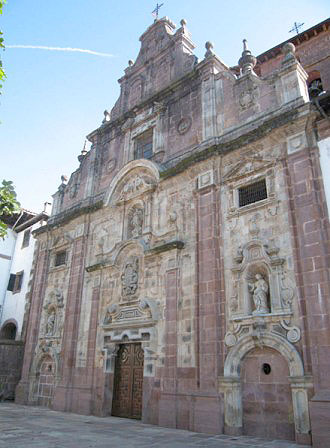
Convent of Our Lady of the Angels of Arizkun
In Azpilkueta the figure of Martín de Elizacoechea was fundamental for the locality. Born in the Dorrea house in 1679, he studied at the University of Alcalá and followed degree program ecclesiastical, which took him to New Spain in 1716. After spending a few years in Mexico City where he was canon of the cathedral, maestrescuela, chantre, archdeacon and dean, he was named bishop of Durango in 1736, from where he went on to occupy the mitre of Valladolid de Michoacán a few years later. The correspondence maintained with his family has allowed us to know in depth his role as protector of his family and, especially, as promoter of the arts. Not only did he finance the reconstruction of his house, but he also answered the call made to him by the President of the parish of Azpilkueta due to the deterioration of the church and sent various remittances that made it possible to build a new parish church of San Andrés between 1750 and 1752, following the plans of Juan Miguel de Goyeneta. With his money, Luis Salvador Carmona was also able to commission the sculptures that would preside over the altarpieces: the titular San Andrés, the Virgin of the Rosary and Santa Bárbara. Those pieces of furniture were executed around 1760 by Silvestre de Soria, the most important architect, carver and sculptor from Navarre in the 18th century, trained in the workshop of the Royal Palace of Madrid. Perhaps they were paid for by Francisco Indaburu, Elizacoechea's nephew-in-law, a native of the Echartenea de Azpilkueta house, which was the Queen's treasure.
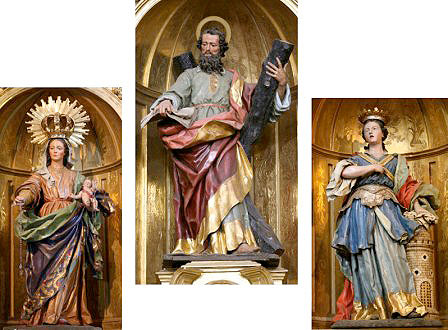
Carvings of Our Lady of the Rosary, St. Andrew and St. Barbara,
works by Luis Salvador Carmona in the parish of Azpilkueta.
The Jáuregui brothers, natives of the palace armory of Oharriz in Lekaroz, sons of Matías de Jáuregui and Juana María de Aldecoa, who had married in 1695, were providential for the parish church of their town. We do not know who paid for their altarpieces, executed again by Soria between 1762 and 1767 and gilded by Pedro Antonio de Rada. Francisco Martín de Jáuregui, a businessman settled in Madrid, not only financed the construction of the family palace in 1748, but also paid for the sculptures of San Bartolomé, San Matías and Santa Catalina of the parish, works by Carmona, which came from Madrid. To the sponsorship of his brother Pedro Fermín, archdeacon of chamber of the cathedral of Pamplona, great promoter of the arts in the mentioned church, we owe the Virgin of the Rosary, a San Juanito and a Child Jesus Redeemer, also from Carmona. It is recorded in the factory books that he also gave an ornament, a set of chalice, paten, cruet and bell, a Lignun Crucis and two reliquaries. Both brothers financed the gilding of the two collateral altarpieces. Finally, to a third brother, Agustín, who became Viceroy of Peru in 1780, we owe an extraordinary gold-embroidered canopy, with its silver rods, which he sent from Lima.
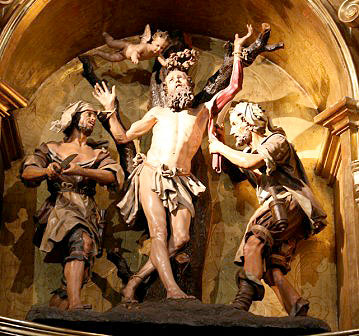
Martyrdom of St. Bartholomew, by Luis Salvador Carmona
Parish of Lekaroz
